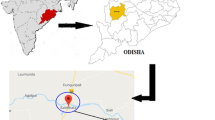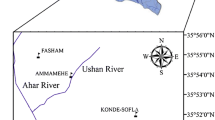Abstract
Here, the assessment of suspended sediment load is evaluated by four ANN algorithms: support vector machine (SVM), cascade-forward back-propagation (CFBP), feed-forward back-propagation (FFBP), and radial basis fewer neuron (RBFN) networks. Techniques are applied to a watershed of arid region, India. Sensitivity in terms of Nash–Sutcliffe coefficient (ENS), correlation coefficient (CC), and ratio between root mean square error and standard deviation (RSR) are computed. Results show that SVM shows preeminent value of RSR 0.0636, ENS 0.8869, and CC 0.9418, while Qt, Qt−1, Qt−2, Qt−3, Qt−4, Pt, Pt−1, Pt−2, Pt−3 architecture is applied. But for the same architecture, FFBP, RBFN and CFBP illustrate that the paramount value of CC is 0.9350, 0.9228, and 0.8985. As a whole, the performance of SVM shows superiority while considering various combinations of discharge and rainfall in contrast to FFBP, CFBP, and RBFN algorithm. Among all techniques, RBFN performs poor as compared to other algorithms. Interpretation of the results will help to compute sediment load in un-gauged catchments.






Similar content being viewed by others
References
A. Agarwal, R.D. Singh, S.K. Mishra, P.K. Bhunya, ANN based sediment yield models for Vamsadhara river basin (India). Water 31(1), 95–100 (2005)
R. Arunkumar, V. Jothiprakash, K. Sharma, Artificial intelligence techniques for predicting and mapping daily pan evaporation. J. Inst. Eng. India Ser. A. 98, 219–231 (2017). https://doi.org/10.1007/s40030-017-0215-1
A. P. Atiken, Assessing systematic errors in rainfall-runoff models. J. Hydrol. 20(2), 121–136 (1973)
N. Bisoyi, H. Gupta, N.P. Padhy, G.J. Chakrapani, Prediction of daily sediment discharge using a back propagation neural network training algorithm: a case study of the Narmada River, India. Int. J. Sedim. Res. 34(2), 125–135 (2019)
K. Budu, Comparison of wavelet-based ANN and regression models for reservoir inflow forecasting. J. Hydrol. Eng. 19(7), 1385–1400 (2014)
D.A.K. Fernando, A.W. Jayawardena, Runoff forecasting using RBF networks with OLS algorithm. J. Hydrol. Eng. 3(3), 203–209 (1998)
O. Kisi, Multi-layer perceptrons with Levenberg Marquardt training algorithm for suspended sediment concentration prediction and estimation. Hydrol. Sci. J. 49(6), 1025–1040 (2004)
O. Kisi, Z.M. Yaseen, The potential of hybrid evolutionary fuzzy intelligence model for suspended sediment concentration prediction. CATENA 174, 11–23 (2019)
K.C. Luk, J.E. Ball, A. Sharma, An application of artificial neural networks for rainfall forecasting. J. Math. Comput. Model 33, 683–693 (2001)
H. Maier, G.C. Dandy, Neural networks for the prediction and forecasting of water resources variables: a review of modelling issues and applications. Environ. Model. Softw. 15, 101–124 (2000)
W.S. Merritt, R.A. Letcher, A.J. Jakeman, A review of erosion and sediment transport models. Environ. Model. Softw. 18(8–9), 761–799 (2003)
A.W. Minns, M.J. Hall, Artificial neural networks as rainfall runoff models. Hydrol. Sci. J. 41(3), 399–417 (1996)
J. E. Nash, J. V. Sutcliffe, River flow forecasting through conceptual model, part 1: a discussion on principals. J. Hydrol. 10, 282–290 (1970)
V. Nourani, M.T. Alami, M.H. Aminfar, A combined neural-wavelet model for prediction of Ligvanchai watershed precipitation. Eng. Appl. Artif. Intel. 22(3), 466–472 (2009)
V. Nourani, M. Komasi, A. Mano, A multivariate ANN-wavelet approach for rainfall–runoff modelling. Water Resour. Manage. 23(14), 2877–2894 (2009)
V. Nourani, M. Komasi, M. Alami, Hybrid Wavelet-genetic programming approach to optimize ANN modeling of rainfall–runoff process. J. Hydrol. Eng. 403(6), 724–741 (2012)
L.S. Pereira, L.C. Andes, A.L. Cox, A. Ghulam, Measuring suspended-sediment concentration and turbidity in the middle Mississippi and Lower Missouri Rivers Using Landsat Data. JAWRA J. Am. Water Resour. Assoc. 54(2), 440–450 (2018)
M. Rahgoshay, S. Feiznia, M. Arian, S.A.A. Hashemi, Modeling daily suspended sediment load using improved support vector machine model and genetic algorithm. Environ. Sci. Pollut. Res. 25(35), 35693–35706 (2018)
M. Rahgoshay, S. Feiznia, M. Arian, S.A.A. Hashemi, Simulation of daily suspended sediment load using an improved model of support vector machine and genetic algorithms and particle swarm. Arab. J. Geosci. 12(9), 277 (2019)
R.K. Rai, B.S. Mathur, Event-based sediment yield modelling using artificial neural network. Water Res. Manage. J. 22, 423–441 (2008)
T. Rajaee, V. Nourani, M. Zounemat-Kermani, O. Kisi, River suspended sediment load prediction: application of ANN and wavelet conjunction model. J. Hydrol. Eng. 16(8), 613–627 (2011)
K. Raza, V. Jothiprakash, Multi-output ANN model for prediction of seven meteorological parameters in a weather station. J. Inst. Eng. India Ser. A 95(4), 221–229 (2014). https://doi.org/10.1007/s40030-014-0092-9
M. Rezaeian Zadeh, S. Amin, D. Khalili, V.P. Singh, Daily outflow prediction by multi-layer perceptron with logistic sigmoid and tangent sigmoid activation functions. Water Resour. Manag. 24(11), 2673–2688 (2010)
J.D. Salas, M. Markus, A.S. Tokar, Stream Flow Forecasting Based on Artificial Neural Networks (Kluwer Publishers, London, 2000), pp. 23–51
S. Samantaray, D.K. Ghose, Evaluation of suspended sediment concentration using descent neural networks. Proc. Comput. Sci. 132, 1824–1831 (2018)
S. Samantaray, D.K. Ghose, Sediment assessment for a watershed in arid region via neural networks. Sadhana 44, 219 (2019)
S. Samantaray, A. Sahoo, Appraisal of runoff through BPNN, RNN, and RBFN in Tentulikhunti Watershed: a case study, in Frontiers in Intelligent Computing: Theory and Applications, vol. 1014, Advances in Intelligent Systems and Computing, ed. by S. Satapathy, V. Bhateja, B. Nguyen, N. Nguyen, D.N. Le (Springer, Singapore, 2020)
S. Samantaray, A. Sahoo, Estimation of runoff through BPNN and SVM in Agalpur Watershed, in Frontiers in Intelligent Computing: Theory and Applications, vol. 1014, Advances in Intelligent Systems and Computing, ed. by S. Satapathy, V. Bhateja, B. Nguyen, N. Nguyen, D.N. Le (Springer, Singapore, 2020)
S. Samantaray, A. Sahoo, Assessment of sediment concentration through RBNN and SVM-FFA in Arid Watershed, India, in Smart Intelligent Computing and Applications. Smart Innovation, Systems and Technologies, vol. 159, ed. by S. Satapathy, V. Bhateja, V. Bhateja, J. Mohanty, S. Udgata (Springer, Singapore, 2020)
K. Samet, K. Hoseini, H. Karami, M. Mohammadi, Comparison between soft computing methods for prediction of sediment load in rivers: Maku dam case study. Iran. J. Sci. Technol. Trans. Civ. Eng. 43(1), 93–103 (2019)
V. Sharma, S.C. Negi, R.P. Rudra, S. Yang, Neural networks in predicting nitrate-nitrogen in drainage water. Agric. Water Manage. 63, 169–183 (2003)
M.B. Shukla, R. Kok, S.O. Prasher, G. Clark, R. Lacroix, Use of artificial neural networks in transient drainage design. Trans. ASAE 39, 119–124 (1996)
H. Torabi, R. Dehghani, Comparison and evaluation of intelligent models for river suspended sediment estimation (case study: Kakareza River, Iran). Environ. Resour. Res. 6(2), 139–148 (2018)
L. Yitian, R. R. Gu, Modeling flow and sediment transport in a river system using an artificial neural network. Environ. Manag. 31(1), 122–134 (2003)
Author information
Authors and Affiliations
Corresponding author
Additional information
Publisher's Note
Springer Nature remains neutral with regard to jurisdictional claims in published maps and institutional affiliations.
Rights and permissions
About this article
Cite this article
Samantaray, S., Ghose, D.K. Assessment of Suspended Sediment Load with Neural Networks in Arid Watershed. J. Inst. Eng. India Ser. A 101, 371–380 (2020). https://doi.org/10.1007/s40030-019-00429-0
Received:
Accepted:
Published:
Issue Date:
DOI: https://doi.org/10.1007/s40030-019-00429-0




